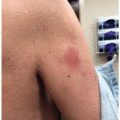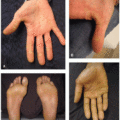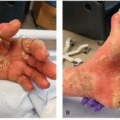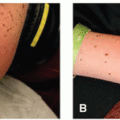Alkylating Agents
Sheila Shaigany
Alkylating agents are highly reactive cytotoxic agents that damage DNA by covalently attaching an alkyl group to guanine molecules present in DNA. This leads directly to either programmed cell death or the cross-linking of base pairs, thereby inhibiting DNA replication. Alkylating agents are divided into the following categories:
Mustard gas derivatives: cyclophosphamide, ifosfamide, chlorambucil, melphalan
Ethylenimines: thiotepa
Alkyl sulfonates: busulfan
Hydrazines and triazenes: procarbazine, dacarbazine, temozolomide
Nitrosoureas: bendamustine, carmustine
Platinum-based agents: cisplatin, carboplatin, oxaliplatin
Although they are cell cycle phase nonspecific, they typically target rapidly dividing cells such as those found in the skin, hair, and nails.
TYPE I HYPERSENSITIVITY REACTIONS
Cutaneous type I hypersensitivity reactions (HSRs) are IgE mediated and can be seen with alkylating agents, most commonly platinum-based agents such as carboplatin, cisplatin, and oxaliplatin. Skin findings present within minutes to hours after receiving therapy and are characterized by flushing, urticaria, pruritus, abdominal cramping, and angioedema. In severe cases, patients may develop anaphylaxis, which along with cutaneous findings involves systemic signs such as tachycardia, hypotension, wheezing, and abdominal pain.
The risk of developing type I HSR with a platinum-based agent increases based on the number of cumulative exposures, most frequently occuring between the fourth and eighth dose, with peak incidence occurring after the eighth cycle and approaching 50% in patients who have received more than 15 infusions.1 Notably, women with inherited BRCA1/BRCA2 mutations demonstrate a higher rate of type 1 HSR to carboplatin and experience rash with a fewer number of exposures.
Management Pearls
Mild to moderate reactions are managed with antihistamines. Pretreatment regimens involving systemic corticosteroids, antihistamines, and leukotriene inhibitors may be effective at preventing subsequent reactions. Severe reactions and/or anaphylaxis require immediate cessation of drug, expedient administration of antihistamines, corticosteroids and subcutaneous epinephrine, and close monitoring.
Intradermal skin testing may be performed after the fifth cycle of platinum-based therapy in order to risk stratify patients and elucidate appropriate candidates for desensitization protocols. Skin testing exhibits highest utility in patients who have already experienced a type 1 HSR and may suggest a higher likelihood of type 1 HSR upon re-exposure even with desensitization.2 8-step and 12-step desensitization protocols for platinum agents have been shown to be safe and potentially effective in preventing type 1 HSR, and can be helpful in allowing a patient labeled as “allergic” to continue receiving first-line therapy.
PIGMENTARY ALTERATION
Pigmentary alteration of the skin, hair, nail, and mucosal surfaces may be seen with alkylating agents, most commonly with cyclophosphamide, and to a lesser extent with thiotepa, busulfan, ifosfamide, and cisplatin.
Cyclophosphamide, the most widely used of the alkylating agents, may present with generalized hyperpigmentation or it may be localized to the palms, soles, nails, or gingival margins of the gums or tongue6 (Figure 22.1A). Transverse or horizontal bands of hyperpigmentation appear at the base of the fingernails or toenails 4 or more weeks after the onset of therapy and move distally with nail growth. With cycles of chemotherapy, transverse dark bands alternate with bands of normal color. Combinations of drugs increase the likelihood of banding of the nails even when the individual drug almost never does this alone. Nails can also have longitudinal or diffuse hyperpigmentation which typically resolves 6 to 12 months after stopping therapy (Figure 22.1B).
Ifosfamide causes hyperpigmentation localized to intertriginous/flexural areas, on the palms, soles, scrotum, and under areas of occlusion. Large areas on the trunk may be affected in severe cases. The hyperpigmentation may exhibit a less predictable course with both variable onset (many months after therapy) and resolution (can fade during therapy or persist even after discontinuation of treatment).7
Stay updated, free articles. Join our Telegram channel

Full access? Get Clinical Tree








